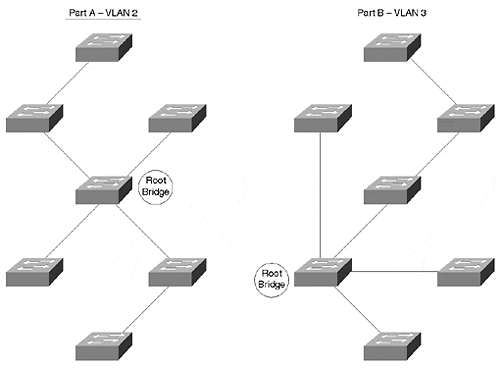All of This Per VLAN
As if the Spanning-Tree Protocol isn't exciting enough all by itself, it turns out that everything already discussed in the chapter actually occurs once per VLAN! In other words, Cisco uses one instance of STP per VLAN. This feature is generally referred to as PVST: per VLAN Spanning Tree.
In other words, every VLAN can have a different Root Bridge and active topology. For example, VLAN 2 could look like part A of Figure 6-23, whereas VLAN 3 could look like part B.
Figure 6-23. PVST Allows You to Create Different Active Topologies for Each VLAN

In fact, this is why there is a vlan parameter on the set spantree command that you saw in the previous section. Every VLAN could have a different set of active paths. Every VLAN could have different timer values. You get the idea.
The fact that Cisco uses one instance of STP per VLAN has two important implications:
It can allow you to tap into many wonderful features such as load balancing and per-VLAN flows.
It can make your life miserable (if you don't know what you are doing).
The goal here is to show you how to maximize the first point and avoid the second.
On the whole, having multiple instances of Spanning Tree gives you a phenomenal tool for controlling your network. Be aware that many vendors only use one instance of STP for all VLANs. Not only does this reduce your control, but it can lead to broken networks. For example, suppose that the single instance of Spanning Tree in VLAN 1 determines the active topology for all VLANs. However, what if you remove VLAN 5 from a link used by VLAN 1 if that link is selected as part of the active topology for all VLANs, VLAN 5 becomes partitioned. The VLAN 5 users are probably pretty upset about now.
Chapter 7 explores how to take advantage of the multiple instances of STP to accomplish advanced tasks such as STP load balancing.
EAN: N/A
Pages: 223